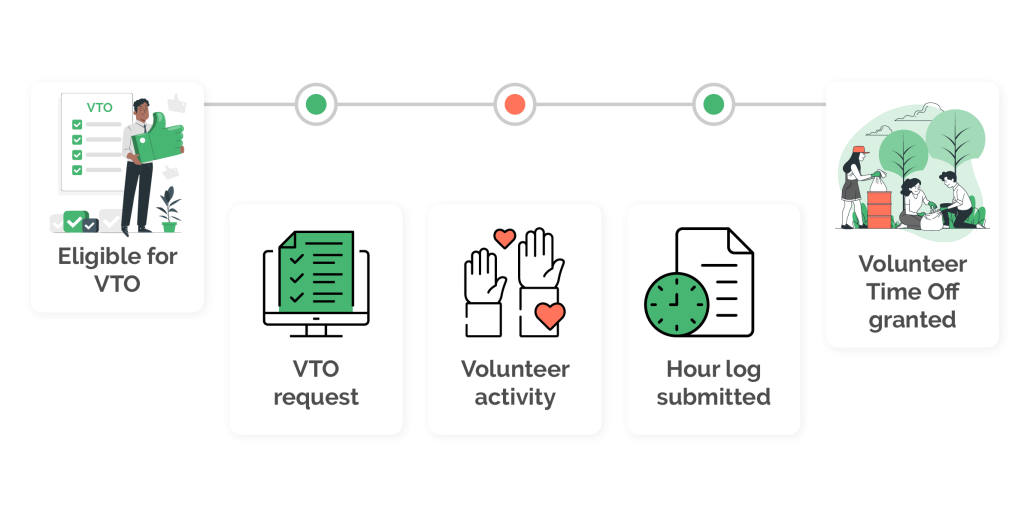The Smart Nonprofit’s Guide to Volunteer Time Off (VTO)
Let’s say you’re having a hard time recruiting and retaining dedicated volunteers for your organization. As a result, you conduct a survey of your supporter base, asking what roadblocks keep them from getting involved. You might expect to hear answers like lack of free time, existing work commitments, or inability to take time from their busy days.
And that makes sense! According to Double the Donation’s volunteer time off statistics, 49% of individuals cite work as the primary obstacle to volunteering. Conversely, only 30% cite one of their reasons for volunteering as having had the time to do so.
In other words, it all comes down to time. Lucky for you, that’s where programs like Volunteer Time Off come in!
In this guide, we’ll cover everything you should know about these initiatives. This includes:
- Understanding Volunteer Time Off Programs
- Top Companies Offering Volunteer Time Off
- Marketing Volunteer Time Off to Your Supporters
Ready to learn more about making the most of volunteer time off programs for your cause? Let’s begin with the basics.
Understanding Volunteer Time Off Programs
The better acquainted you are with volunteer time off opportunities, the better you’ll be able to target the programs for your organization. Here’s what you need to know to get started!
What is Volunteer Time Off (VTO)?
Volunteer Time Off (also known as VTO) is a type of corporate benefit that grants employees paid time away from their regular job responsibilities to volunteer for nonprofit organizations or community causes. Unlike traditional paid time off used for vacation or personal days, VTO is offered above and beyond these hours, specifically designated for volunteering activities.
By offering VTO, companies empower their staff to give back without sacrificing their personal or vacation time, making it easier for employees to participate in meaningful service opportunities. This type of program reflects a company’s commitment to corporate social responsibility while actively encouraging employees to engage in their communities and support causes they care about.
Volunteer Time Off Guidelines to Know
When promoting or participating in a Volunteer Time Off (VTO) program, it’s essential to be familiar with the specific guidelines that come with the program. It’s also important to recognize that these guidelines can vary widely from one company to the next.
Still, here are a few common guidelines to keep in mind:
Employee Eligibility: Some companies implement eligibility criteria regarding team members qualifying for the programs. For example, there may be a minimum tenure or full-time employment status required before employees can take advantage of VTO.
Allotted or Accrued Time: Employers typically set a specific number of VTO hours, often ranging from 8 to 40 hours (with an average of 20 per year), for their employees to use. This time may be allotted all at once (e.g., 40 hours per year) or accrued over a set time period (10 hours per quarter).
Approved Organizations: While VTO is generally limited to volunteering with registered nonprofits or schools, it’s a good idea to check if a company has any additional requirements. For example, some employers may have a list of pre-approved charities or causes that align with their corporate values.
Approved Activities: Beyond the organization itself, it’s also important to ensure that the activities completed as part of a VTO program are included in program guidelines. For example, an employee participating in their child’s PTA meeting may not qualify for VTO hours, while assisting with a school-sanctioned fundraiser would.
An Overview of the VTO Process
Key Benefits of Volunteer Time Off Programs
Volunteer Time Off programs offer significant benefits to nonprofits, employees, and companies alike. Here’s a look at how each group can benefit:
Nonprofits:
- Increased Volunteer Support: VTO programs encourage a steady flow of committed volunteers, providing nonprofits with reliable and consistent assistance.
- Access to Skilled Volunteers: Nonprofits benefit from the expertise and skills employees bring when they volunteer, helping them achieve their mission more effectively.
- Corporate Partnerships: Nonprofits often form lasting partnerships with companies offering VTO, which can lead to additional support through donations, sponsorships, or grants.
Employees:
- Increased Job Satisfaction: Employees feel valued and supported when their employer encourages them to give back, leading to greater job satisfaction.
- Simplified Nonprofit Support: VTO allows employees to contribute to causes they care about without using personal time or vacation days. The easier it is to support their favorite nonprofits, the more likely they are to do so.
- Skill Development: Volunteering provides opportunities for employees to develop new skills and strengthen existing ones, such as leadership, teamwork, and problem-solving.
Companies:
- Enhanced Employee Engagement: VTO programs promote a positive company culture, boost morale, and increase employee loyalty, reducing turnover rates.
- Improved Brand Reputation: Companies that offer VTO demonstrate a commitment to social responsibility, enhancing their image among customers, stakeholders, and potential employees.
- Stronger Community Connections: By supporting employees in volunteering, companies build stronger relationships with local communities and charitable organizations.
These benefits make VTO programs a win-win for everyone involved, fostering a culture of giving and strengthening communities.
Top Companies Offering Volunteer Time Off
According to Double the Donation, more than 65% of companies provide some sort of paid-release time program. Becoming familiar with the businesses offering these programs will allow your team to better identify and target opportunities in your network. In order to aid you in doing so, we’ve compiled a list of exemplary VTO opportunities below:
Patagonia
Volunteer time off per year: 18 hours
Patagonia encourages its employees to engage in community service by providing 18 hours of paid volunteer time off per year. Not to mention, it also offers two-month internship opportunities in which employees can work with their preferred environmental charities while receiving their full pay and benefits!
This program reflects the company’s commitment to environmental and social responsibility, empowering employees to participate in causes they care about.
Hasbro
Volunteer time off per year: 48 hours (4 per month)
Hasbro offers an extensive VTO program that grants employees 48 hours of paid time off for volunteering, which breaks down to 4 hours per month. This initiative supports the company’s mission to inspire creativity and play while encouraging employees to give back to their communities.
Deloitte
Volunteer time off per year: 8 hours
Deloitte provides 8 hours of paid volunteer time off per year to its employees. This initiative allows team members to engage in meaningful volunteer activities, fostering a culture of service and community involvement within the organization.
Bank of America
Volunteer time off per year: 104 hours (2 per week)
Bank of America has one of the most generous VTO programs, offering 104 hours of paid time off for volunteering, equivalent to 2 hours per week. This robust program underscores the company’s commitment to community service and employee engagement.
Warner Media
Volunteer time off per year: 40 hours
Warner Media allows employees to take 40 hours of paid time off for volunteering each year. This program encourages staff to participate in charitable activities and supports the company’s commitment to social responsibility.
Cisco
Volunteer time off per year: 80 hours
Cisco offers 80 hours of paid volunteer time off per year, empowering employees to dedicate substantial time to community service. The program highlights Cisco’s commitment to social impact and encourages team members to engage with local organizations and initiatives.
GM Financial
Volunteer time off per year: 32 hours (8 per quarter)
GM Financial provides 32 hours of paid volunteer time off annually, which breaks down to 8 hours per quarter. This initiative encourages employees to volunteer regularly throughout the year, promoting ongoing community engagement.
Johnson & Johnson
Volunteer time off per year: 40 hours
Johnson & Johnson offers 40 hours of paid volunteer time off each year, allowing employees to contribute to various charitable activities. This program reflects the company’s long-standing commitment to health and community well-being.
Plus, in the event of a natural disaster, Johnson & Johnson increases its maximum threshold to 80 hours, enabling employees to get involved in times of crisis.

Marketing Volunteer Time Off to Your Supporters
Volunteer time off programs can go a long way in strengthening volunteerism at your organization. However, a significant portion of your audience is likely unfamiliar with the opportunity—including those who qualify for the programs through their employers.
That said, driving awareness by marketing VTO initiatives to your audience is a must. And we’ve outlined a few recommendations for doing so below:
Marketing VTO on your nonprofit website
Your nonprofit or school’s website is one of your most essential marketing assets. Luckily, it can be used to promote VTO programs with ease—in a few different ways. These include:
- Creating a dedicated “Volunteer Time Off” page or informational blog post
- Adding a section about VTO to your existing “Volunteers” or “Ways to Give” pages
Regardless of where you promote the programs, it’s a good idea to make researching opportunities as quick and easy as possible. For this, we recommend implementing a company database search tool like Double the Donation Volunteering.
Then, once you have the information you need on your site, be sure to link to the resource from your other marketing materials as well.
Marketing VTO using email communications
Promoting Volunteer Time Off (VTO) through email can be an effective way to engage supporters and encourage participation. Here are some strategies to effectively market VTO using email communications:
- Create a dedicated email campaign: Design a specific email campaign focused on VTO, outlining the program’s details, benefits, and how supporters can get involved. Don’t forget to use a compelling subject line to grab attention and entice recipients to open the email!
- Add a section about VTO to your upcoming newsletters: Rather than a dedicated email blast, try slotting a blurb about the programs in an existing email resource. This will allow your team to get details about VTO out alongside other valuable information!
- Send follow-up emails to volunteers: Take a personalized approach to pursuing VTO opportunities by directly emailing potentially interested volunteers. After individuals support your organization, follow up with a reminder to check their eligibility for volunteer time off programs and more.
By implementing these strategies, nonprofits can effectively promote their Volunteer Time Off programs through email, encouraging greater participation and fostering a culture of volunteerism among their supporters.
Marketing VTO on social media
Marketing volunteer time off programs on social media can be a powerful way to reach a broader audience and engage supporters with the programs. While you’ll want to cater your marketing plan to your organization’s existing strategies, check out the following tips for promoting VTO through social media:
- Create Engaging Content: Develop visually appealing posts that highlight your VTO program. Use graphics, photos, and videos that showcase volunteers in action, emphasizing the impact of their work to capture your followers’ attention and encourage their involvement.
- Share Success Stories: Post testimonials or stories from employees or volunteers who have benefited from VTO. Highlight their experiences, the activities they volunteered with, and the positive changes they made in the community and on your mission.
- Use Hashtags: Incorporate relevant hashtags related to volunteering, community service, and VTO to increase visibility and reach a wider audience. Consider creating a unique hashtag for your nonprofit’s VTO program to track engagement and participation.
- Provide Information and Resources: Use social media to educate followers about VTO. Share posts that explain what VTO is, how it works, and the benefits for the community overall. Include links to your website or dedicated VTO pages for more detailed information.
By utilizing these strategies, nonprofits can effectively market their Volunteer Time Off programs on social media, engage their supporters, and inspire more individuals to take action.
Marketing VTO through text message
Text messages can be an effective way to reach your supporters where they are in a quick and direct manner. By marketing VTO through text, you can spread the word about the programs using mobile communications.
. Here are several strategies for doing so:
- Send Quick Announcements: Use text messaging to inform supporters about the VTO program and its benefits. Keep messages concise and to the point, highlighting key details such as the number of hours available for volunteering and how to participate.
- Promote Upcoming Events: Send text reminders about specific volunteer opportunities or events that allow supporters to use their VTO. Include details such as the date, time, location, and any registration links to make it easy for recipients to get involved.
- Create Urgency: Use text messages to create a sense of urgency around VTO opportunities. Phrases like “Limited spots available!” or “Sign up by Friday!” can encourage immediate action and participation.
- Provide Easy Call-to-Action Links: Include links in text messages that direct recipients to your nonprofit’s website or a specific VTO page. This allows supporters to quickly access more information and take action.
- Segment Your Audience: If possible, segment your audience based on previous engagement or interests. Tailor text messages to specific groups, such as employees who have utilized VTO before or those who have expressed interest in volunteering.
By leveraging these strategies, nonprofits can effectively market their Volunteer Time Off programs through text messaging, reaching supporters in a timely and direct manner while encouraging participation and engagement.
Marketing VTO with paid advertising channels
Advertising can be a great way to reach new audiences with your message—and don’t let the “paid” in paid advertising slow you down. Nonprofits and schools can access up to $10,000 worth of free advertising credits through Google’s Ad Grant program.
With free access to this paid search advertising platform, it’s easy to increase visibility and engagement with your cause. All you need to do is target keywords related to VTO and volunteer time off and direct users to the educational resources on your website!
Next Steps & Additional VTO Resources
Volunteer Time Off programs present a powerful opportunity for nonprofits, companies, and employees to work together toward a positive community impact.
By understanding the benefits of and best practices for engaging in VTO, nonprofits like yours can better leverage these programs to fulfill their missions with greater volunteer support. Good luck!
Interested in learning more about Volunteer Time Off and other corporate giving programs? Check out these additional resources:
- Top Volunteer Time Off Companies | 35 Programs to Know. Drive Volunteer Time Off for your organization by targeting these standout programs! See if your supporters work for these companies and get started.
- Standout Strategies for Leveraging Corporate Volunteer Incentives. Dive deeper into corporate volunteer incentive programs—including VTO and more. Get the free downloadable resource to grow your knowledge.
- Corporate Volunteer Grants: The Basics & How to Secure Them. Volunteer grants offer another excellent opportunity for organizations to better engage their volunteers. Find out what you should know about the programs here!





